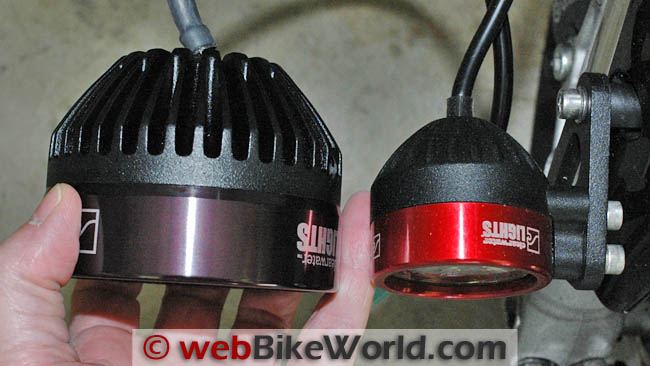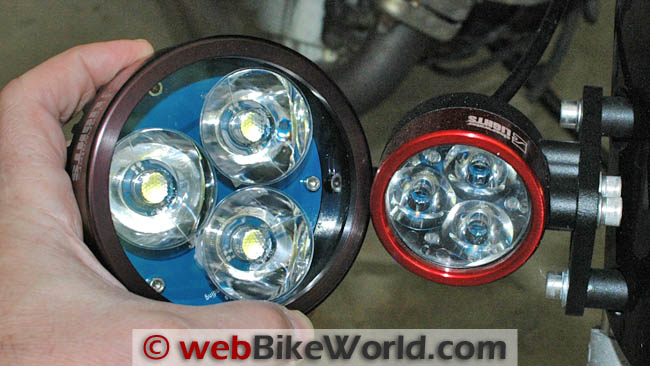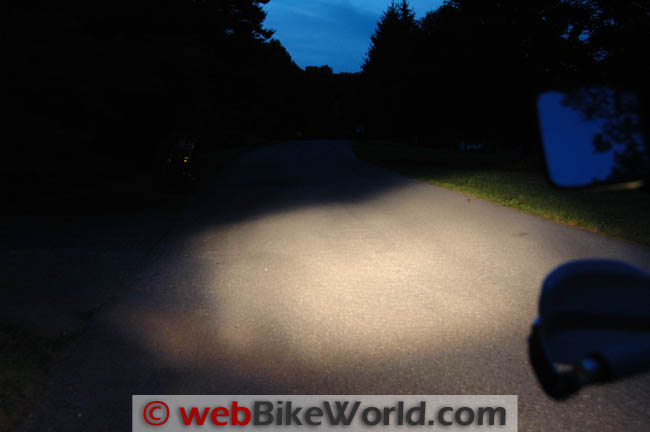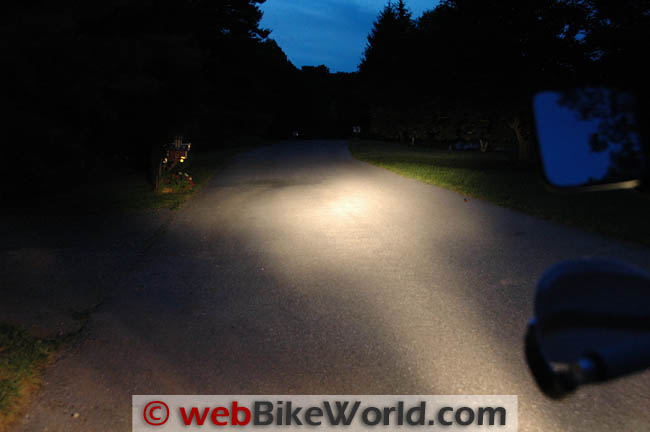|
|
楼主 |
发表于 2011-7-31 23:34:40
|
显示全部楼层
Clearwater Krista Lights
Clearwater "Krista" LED Lights Review by Rick K. webBikeWorld.com
More: wBW Reviews Home | Owner Comments (Below)
See Also: Clearwater Glenda LED Lights Review

Summary
The Clearwater Krista lights use the latest generation of LEDs for retina-melting power at minimum draw.
The light output can be varied by turning a rotating dial or the lights can be turned off completely.
The quality of construction, mounting hardware and the light output are outstanding.
Background
In the 12 or so years that Burn and I have been messing around with LED motorcycle lighting we've witnessed an incredible evolution of the technology.
What was once considered a novelty for vehicle use is now a mainstream lighting technology, with LED tail lights now commonly used on many types of vehicles.
The newest generation of LEDs now power auxiliary driving lights with output that would have been unimaginable only a couple of years ago.
The Clearwater "Krista" lights are an example of how far LED lighting has come. Their light output is simply amazing and makes even the most powerful motorcycle headlight look wimpy.
Introduction
The Clearwater Krista light units are made in the U.S.A., machined from aluminum billet and hard anodized and powder coated. The wiring and connectors are aircraft grade and the wiring is silver plated and uses Teflon insulation, according to Clearwater.
These are big, mean-looking lights, measuring 95 mm (3.75") in diameter and 72 mm (2.8") deep. They have thick acrylic lens covers that are replaceable and Clearwater also has amber-colored lenses for the units. The lights come with powder-coated U-shaped brackets and the kit includes all the wiring and high-quality stainless steel hardware.
An on-off switch and the dimmer rotator is also provided. The dimmer controls a specially designed digital circuit in the Krista lights that allows the light output of each light to be varied.
Each Krista unit contains three LEDs and each LED can be varied from 4 Watts up to the maximum of 12 Watts, which means that each Krista light unit draws from 12 Watts at the dimmest setting to 36 Watts at full power (72 Watts for the pair).
Consider that a standard headlight is 55 Watts on low beam and 60 Watts on high and even a brake/tail light draws 21 Watts. So even an electrical wimp like the Suzuki DR650 (blog) has enough juice left over to handle the Krista lights; its alternator puts out 200 Watts at 5,000 RPM, according to the shop manual.
A rough calculation for the DR650 includes the 55/60 Watt headlight; 21 Watts for a turn signal and another 21 Watts for the brake light; 5 Watts for the license plate light and 6 Watts total for instrument lights. That leaves about 87 or so Watts left over -- just enough for the Krista lights. Don't forget the starter motor draw, but the solution to that is to not start the bike with the lights on!
Current draw can also be reduced somewhat by installing LEDs for the turn signals and brake lights and an HID headlight. We have an HID low/high beam headlight kit for the DR650 on order; it's claimed draw is only 35 Watts. And there's a new 250-Watt stator available for the DR650; we ordered one of those also just to be on the safe side.
I'm not worried about heated grips or clothing because I use the excellent Gerbings Hybrid battery heated gloves (review) or the Warmthru G4 battery heated gloves (review) in the winter, along my current favorite cold-weather liner, the Gerbings "Core Heat" battery heated vest (review).
One of the major benefits of LED technology is that it provides lighting options that are not otherwise available for motorcycles with limited electrical systems.
One other big benefit of the Krista LED light kit is the variable output controller. This allows the lights to be used on low power during the day to serve as visibility or marker lights, or half-power can be used with either the low or high beam at night, or full power can be chosen for maximum output.
Note that the beam pattern of the Krista lights is broad and unfocused because the lights were designed primarily for off-road use for illuminating dark trails, which is how the majority of these powerful auxiliary lights are sold.
You do not want to use the Krista lights at full power if there is oncoming traffic and you don't want to peer directly into the lights either -- they are very, very bright.


The Clearwater Krista LED light (on the left in each photo) is a true driving light, compared to the Clearwater Glenda LED lights (review), which are more or less designed as visibility or marker lights.
Let There Be Light!
Let's get right to it: following are photos taken at night of the stock 55 Watt low beam halogen light output of the Suzuki DR650, the 60 Watt halogen high beam and then the Krista lights at full power with the DR650 high beam. I think the results are obvious.
The DR650 actually has a decent low and high beam, as motorcycle lights go. The reflector is nicely shaped to put out a good pattern. But the Clearwater Krista lights show a dramatic difference in light output for this bike.
Each of these photos was taken at a focal length of 46 mm (35 mm equivalent) at f6.3 and a 0.5 second shutter speed at ISO800. This means the light outputs are comparable, as the camera did not try to compensate the exposure between the different headlight outputs. The photos were reduced to 650 pixels in width and slightly sharpened but were not otherwise modified.
The bike is on its side stand with no rider, so the light output is slightly lower than it would be with weight on the bike, but it works for comparison purposes.

Suzuki DR650, stock 55 Watt low beam.

The stock 60-Watt high beam on the Suzuki DR650 is better than most.

|
|
 |小黑屋|手机版|摩托坊(MOTOF.cn)
( 粤ICP备2020133911号-1 )
|小黑屋|手机版|摩托坊(MOTOF.cn)
( 粤ICP备2020133911号-1 )